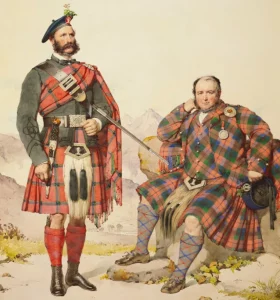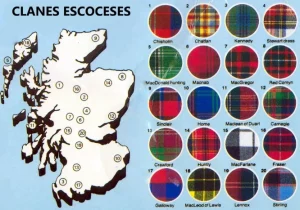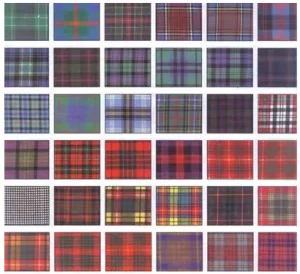Why is Tartan so popular in Scotland?
Introduction
From the windswept Highlands to the bustling streets of Edinburgh, one iconic pattern reigns supreme: Tartan. It’s more than just a crisscross of colourful threads; it’s a symbol of heritage, a badge of honour, and a timeless fashion statement woven into the very fabric of Scottish identity. But what is it about this distinctive pattern that has captivated Scotland and the world for centuries?
Join us on a journey through time as we unravel the rich and complex history of Tartan, from its ancient origins to its modern-day resurgence. And discover how you can embrace this enduring symbol of Scotland with our exquisite collection of Tartan shawls and capes.
The Ancient Threads of Identity: The Origins of Tartan
Long before Tartan was associated with specific clans, it was a practical and popular textile in the Scottish Highlands. The word “Tartan” is thought to derive from the French word tiretaine, referring to a type of woollen cloth.
Weaving with the Land
Early weavers used natural dyes derived from local plants, berries, and minerals to create the vibrant colours of their Tartans. This meant that the patterns, or setts, varied from region to region, reflecting the natural landscape. A weaver on the coast might use seaweed for a deep purple, while someone inland would use lichens to create a vivid orange. These early Tartans were a reflection of the weaver’s environment, a sartorial map of their homeland.
A Symbol of Community
While not yet the rigid clan identifiers they would become, these regional Tartans fostered a sense of community and belonging. To see someone wearing a similar pattern was to recognize them as one of your own, a neighbour from the same glen or island.
The Colours of a Clan
The colours woven into a clan’s Tartan were often imbued with special meaning. Reds could signify courage and warfare, greens the lush landscapes of their territory, and blues the rivers and lochs that sustained them. Each thread told a story, weaving together the history, values, and identity of the clan.
The Act of Proscription: A Threat to Tartan’s Existence
The powerful symbolism of Tartan was not lost on the British government. Following the Jacobite Rising of 1745, the government sought to suppress Highland culture and dismantle the clan system.
The Dress Act of 1746
In a bid to crush the rebellious spirit of the Highlanders, the Dress Act of 1746 was passed, making it illegal for men and boys to wear Highland dress, including the kilt and Tartan. To be caught wearing Tartan was to risk imprisonment or transportation. This act was a devastating blow to Highland culture, attempting to erase a powerful symbol of Scottish identity.
A Flame That Wouldn’t Die
Despite the ban, the spirit of Tartan lived on. The Highland regiments of the British Army were exempt from the Dress Act, and their continued use of Tartan in their uniforms kept the tradition alive. In the hearts and minds of the Scottish people, Tartan remained a potent symbol of defiance and resilience.
A Royal Seal of Approval: The Romantic Revival of Tartan
After 35 years, the Dress Act was repealed in 1782. What followed was a remarkable resurgence in the popularity of Tartan, fueled by the Romantic movement and a royal visit.
Sir Walter Scott and King George IV
In 1822, King George IV visited Edinburgh, the first reigning monarch to do so in nearly two centuries. The visit was masterfully stage-managed by the novelist Sir Walter Scott, who encouraged the people of Scotland to embrace their Highland heritage and attend the royal engagements in their finest Tartan. The King himself appeared in a kilt, giving Tartan the ultimate royal endorsement.
Queen Victoria’s Highland Fling
The popularity of Tartan soared to new heights during the reign of Queen Victoria. The Queen and her husband, Prince Albert, were deeply enamoured with Scotland, purchasing Balmoral Castle in the Highlands. Their love for all things Scottish, and their frequent appearances in Tartan, cemented its status as a fashionable and desirable textile across Britain and beyond.
Tartan A Timeless Trend
From the catwalks of Paris to the high streets of Tokyo, Tartan’s appeal is now truly global. It has been embraced by punk rockers and royalty, fashion designers and filmmakers, all drawn to its rich history and timeless aesthetic.
But in Scotland, Tartan remains something more. It is a living, breathing part of the national identity, a connection to the past and a symbol of pride for the future.
Embrace the Legacy: Our Tartan Shawls and Capes
What better way to connect with this rich history than by wrapping yourself in the warmth and beauty of a Tartan shawl or cape? Our collection is a celebration of Scottish heritage, offering a timeless piece of craftsmanship that you can treasure for years to come.
Whether you’re looking for a classic clan Tartan to honour your ancestry or a contemporary design to make a fashion statement, our shawls and capes are the perfect way to incorporate this iconic pattern into your wardrobe. They are versatile, elegant, and imbued with the stories and spirit of Scotland.
Have you ever wondered about your own clan Tartan? Let us know in the comments below, and we’d be happy to help you discover the pattern that tells your family’s story!
Custom Tartan Shawls and Capes
For those looking for a truly unique piece, we are proud to offer a bespoke design service. Imagine creating a Tartan that is entirely your own, a pattern that reflects your personal style, your family’s story, or your company’s brand.
With our custom service, you can choose the colours, the pattern, the fabric, and the style to create a one-of-a-kind Tartan shawl or cape. Whether it’s a special gift, a corporate identity, or a personal heirloom, we can help you weave your own story into this timeless Scottish tradition. Contact us today to begin your design journey.






